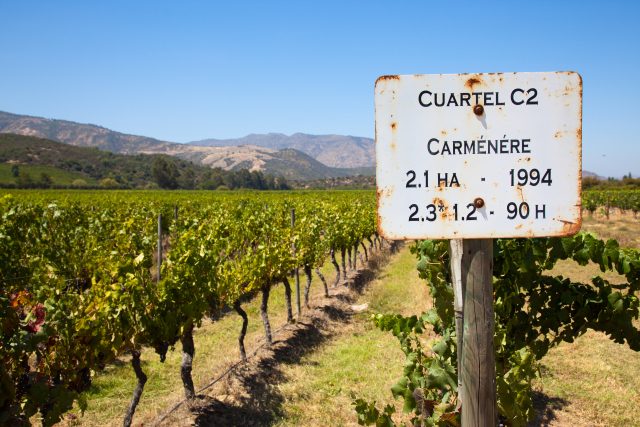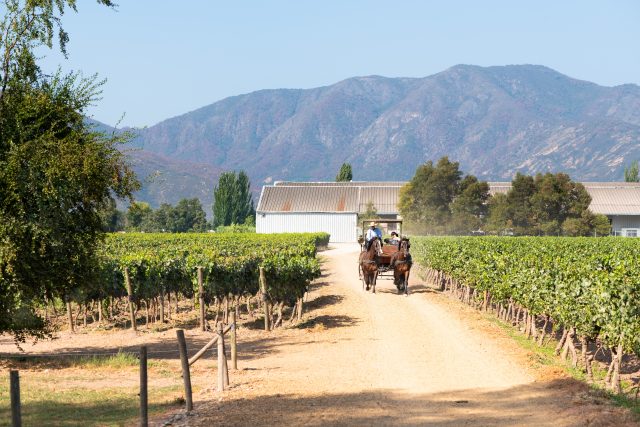This website uses cookies so that we can provide you with the best user experience possible. Cookie information is stored in your browser and performs functions such as recognising you when you return to our website and helping our team to understand which sections of the website you find most interesting and useful.
Carménère continues its unstoppable march in Chile
One variety cropped up consistently throughout Tim Atkin’s Chile Report 2022, and we’re not talking about Cabernet Sauvignon. The drinks business investigates why Carménère is so exciting in the South American country right now.

At a tasting and masterclass held on Tuesday 5 July to mark the unveiling of Tim Atkin’s Chile Special Report 2022, one variety that consistently stood out was Carménère.
With 28 single varietal Carménère wines scoring 93 points or above, and many more high-scoring wines using Carménère in their blends, the grape repeatedly impressed, giving the country’s historical favourite, Cabernet Sauvignon, a run for its money.
Spanning regions as diverse as Colchagua and Los Lingues to Cachapoal, Maipo Norte and Peumo, Carménère appeared to flourish almost the length and breadth of Chile this year, but it was in a vineyard in Alto Jahuel, in 1994, that the variety was rediscovered.
“Chile is particularly well-placed to grow Carménère. We have the ideal conditions for the variety, as proven by the fact that it is able to thrive here while it was devastated by phylloxera in Europe,” says Emily Faulconer, winemaker at Viña Carmen, the producer widely credited for rediscovering Carménère in Chile. It was while walking through the vines here that French ampelographer Jean Michel Boursiquot twigged that what had been thought of as Merlot was in fact the forgotten Bordeaux variety .
While Carménère has been a flagship wine in Chile for some years, it is starting to make waves internationally. According to Faulconer, the acclaim that Carménère is enjoying now is the culmination of the last five to eight years of R&D into the variety.
“I think there has been an evolution in how we manage Carménère, which is opening new doors,” she told the drinks business.
“We have definitely learned through trial and error and we have a much deeper understanding of the variety and its behaviour, in terms of soil management, canopy management, picking times and vinification. I would say that in the last five to eight years we have been able to make truly great Carménères; fresher wines with sweet tannins that are very versatile, either on their own or as part of blends.”
Others attribute Carménère’s coming-of-age to the recent emergence of new clones “which are elevating the production and quality potential of the variety”, Paul Konar, general manager, Cono Sur, told db.
“Because of this, Carménère will probably pick up in planted surface and production in the coming years.”

According to 2019 figures, there are already 10,732 hectares of Carménère planted in Chile, but the variety has shown itself to be a hugely terroir-dependent variety.
“In Chile, Carménère was able to quietly establish itself in various valleys, but it has proven to be at its best in warmer conditions, mostly in very old vineyards which are dry farmed,” Faulconer told db.
“Fertile soils and cold weathers are not beneficial for this variety. At Viña Carmen, we are very focused in Apalta for Carménère, with fantastic results. But we have also ventured into the Cauquenes region with good results in our first vintages.”
In the Colchagua valley, says Faulconer, “where the best Carménère grows”, there is a higher annual rainfall but crucially, this is concentrated in the winter months. The fortuitous timing means low rain during ripening season, which staves off botrytis, to which the variety is sensitive. Low humidity in summer months, and soils with good drainage and depth all help to facilitate optimum ripening of Carménère.
“I believe the great opportunity Chile offers for the production of Carménère is that rains are concentrated in winter and therefore the ripening season is dry,” Faulconer explains. “With this, we can manage vigour, stop the growth process before veraison and ensure good ripening free of the excessive vegetal character that is the usual problem of Carménère when it does not grow in adequate conditions.”
Errazuriz, Casa Silva, Santa Rita, De Martino and Ventisquero all had Carménère wines scoring upwards of 93 in Atkin’s Chile Report 2022, while TerraNoble bagged the top spot for its 96-point TerraNoble CA2 Carménère Costa.
For Cono Sur, which received a 91 point score for its Single Vineyard Block 28 Carménère (a 100% Carménère), the variety’s future looks strong.
“Even though Carménère is not as relevant for us as other varieties like Pinot Noir, Sauvignon Blanc or Cabernet Sauvignon, in some markets such as Eastern Europe and Asia it is very important for us and growing,” says Paul Konar, who revealed that Cono Sur has around 100ha of Carménère planted, mostly in Rapel and Colchagua Valley.
“We are planning to grow our planted surface of Carménère in more than 60% of our hectares in the next three years,” he said.
For Viña Carmen, it’s Brazil, China, Japan, Colombia and the US which buy the most Carménère, and Faulconer says she plans to focus on the variety in the coming years.
“We believe in the potential of Carménère – for Chile and for Viña Carmen as having a big role to play with our experience in this variety.”
Cabernet Sauvignon Vs Carménère
Despite both varieties being genetically related to Cabernet Franc, there are clear differences between Chilean Cabernet Sauvigon and Carménère in in terms of flavour profile.
“Cabernet Sauvignon has blackcurrants, blackberries, some spices with cedar notes. On the other hand, Carménère shows spices, blueberries, pepper and tobacco,” says Faulconer.
“Unlike Cab Sauv, Carménère is not as built up in the mid palate, with this being much more intense in Cab. However, when Carménère reaches good ripeness, it can achieve a deepness and persistency, being especially smooth. Other varieties that are rich in the mid palate, such as Syrah, can blend very well with Carménère.”
Related news
Arnault eyes recovery as LVMH weathers 2024 challenges
Hallgarten on duty: 'a material impact across our entire portfolio'

